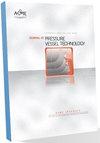双向多孔Fg壳板的非线性热力学静、动态响应及实验验证
IF 1.4
4区 工程技术
Q4 ENGINEERING, MECHANICAL
Journal of Pressure Vessel Technology-Transactions of the Asme
Pub Date : 2023-03-20
DOI:10.1115/1.4062154
引用次数: 3
摘要
本文研究了不同几何形状的FG多孔壳板在热机械载荷作用下的非线性静态和动态挠度/应力特性。非线性弯曲和应力响应是使用基于有限元的数学模型计算的,该模型是使用高阶剪切变形理论(HSDT)开发的。利用格林-拉格朗日非线性应变(GLNS)引入了大变形引起的几何非线性。Voigt的微观力学模型与幂律(GT-I)、s形(GT-II)和指数(GT-III)类型的材料分级模式相结合,用于评估分级面板的有效性能。此外,本工作还考虑了均匀(PRT-I)和不均匀(PRT-II)的孔隙率分布。温度相关(TD)特性与可变温度场相结合,即均匀(TD-i)、线性(TD-II)和非线性(TD-III),用于计算弯曲响应。直接迭代法用于评估所需的非线性响应。通过元素灵敏度分析验证了计算模型的稳定性。此外,通过将目前的数值结果与现有的公布数据和实验评估结果进行比较,验证了所提出的模型的准确性。该实验是通过制造一些天然纤维增强的线性变化层状面板进行测试运行的。最后,将分析扩展到考察几个设计相关参数对考虑热环境条件的FG弯曲/平板的非线性静态和瞬态弯曲和应力响应的影响。本文章由计算机程序翻译,如有差异,请以英文原文为准。
Nonlinear Thermomechanical Static and Dynamic Responses of Bidirectional Porous Fg Shell Panels and Experimental Verifications
The nonlinear static and dynamic deflection/stress characteristics of the porous FG shell panel with various geometrical shapes subjected to thermomechanical load are studied in the present article. The nonlinear flexural and stress responses are computed using the FE-based mathematical model developed using higher-order shear deformation theory (HSDT). The large-deformation induced geometric nonlinearity is incorporated using Green-Lagrange nonlinear strains (GLNS). Voigt's micromechanical model, in association with power-law (GT-I), sigmoid (GT-II) and exponential (GT-III) kinds of material grading patterns, are utilized to evaluate the effective properties of the graded panel. Also, even (PRT-I) and uneven (PRT-II) porosity distributions are considered in the present work. The temperature-dependent (TD) properties are adopted in association with variable temperature fields, i.e. uniform (TD-I), linear (TD-II) and nonlinear (TD-III) for the computation of flexural responses. The direct iterative method is used to evaluate the desired nonlinear responses. The stability of the computational model is verified using elemental sensitivity analysis. Also, the proposed model's accuracy is checked by comparing the present numerical results with the available published data and experimentally evaluated results. The experiment was carried out by fabricating a few natural fibre-reinforced linearly varying layerwise panels for the test run. Finally, the analysis is extended to examine the influence of several design-associated parameters on the nonlinear static and transient flexural and stress responses of the FG curved/flat panel considering thermal environmental conditions.
求助全文
通过发布文献求助,成功后即可免费获取论文全文。
去求助
来源期刊
CiteScore
2.10
自引率
10.00%
发文量
77
审稿时长
4.2 months
期刊介绍:
The Journal of Pressure Vessel Technology is the premier publication for the highest-quality research and interpretive reports on the design, analysis, materials, fabrication, construction, inspection, operation, and failure prevention of pressure vessels, piping, pipelines, power and heating boilers, heat exchangers, reaction vessels, pumps, valves, and other pressure and temperature-bearing components, as well as the nondestructive evaluation of critical components in mechanical engineering applications. Not only does the Journal cover all topics dealing with the design and analysis of pressure vessels, piping, and components, but it also contains discussions of their related codes and standards.
Applicable pressure technology areas of interest include: Dynamic and seismic analysis; Equipment qualification; Fabrication; Welding processes and integrity; Operation of vessels and piping; Fatigue and fracture prediction; Finite and boundary element methods; Fluid-structure interaction; High pressure engineering; Elevated temperature analysis and design; Inelastic analysis; Life extension; Lifeline earthquake engineering; PVP materials and their property databases; NDE; safety and reliability; Verification and qualification of software.

 求助内容:
求助内容: 应助结果提醒方式:
应助结果提醒方式:


